Thomas Kilpper
geboren 1956 in Stuttgart, lebt in Berlin
Das Sein bestimmt das Bewußtsein – Teil 2
18. Juni bis 12. Juli 2025, geöffnet nach Vereinbarung
Provinz Showroom

images courtesy Galerie Nagel Draxler & Thomas Kilpper
Gesellschaftliche Konflikte und historische Prozesse lassen sich nur im Zusammenhang mit den sozialen Bedingungen verstehen. „Die Geschichte aller bisherigen Gesellschaft ist die Geschichte von Klassenkämpfen“, heißt es im Manifest der Kommunistischen Partei – ein Gedanke, der das Werk von Thomas Kilpper grundlegend beeinflusst. Bei Provinz präsentiert der Künstler unter dem Titel „Das Sein bestimmt das Bewußtsein, Teil 2“ eine besondere Auswahl aktueller Holzschnitte.
Gezeigt werden Blätter aus der Porträtserie „Woodcut Maelstrom“, die kürzlich in der Kunsthalle Bremen zu sehen war und die Zeitkritiker*innen in Dialog u.a. mit dem Werk Ernst Ludwig Kirchners treten lassen. Geister, nächtliche Landschaften, Baumsilhouetten, Heilpflanzen, Planeten und Tablettenblister, aufscheinend hinter und vor matten oder leuchtenden, konstruktivistischen Farbkompositionen, zeichnen ein Stimmungsbild zwischen Melancholie und Aufbruch.
Mit der Wahl des Holzschnitts, steht Kilpper in einer langen Tradition von Künstler*innen, die diese Technik als zugängliche, reproduzierbare und erschwingliche Ausdrucksform für ihre Gesellschaftskritik nutzen - von papstkritischen Darstellungen um 1500 bis zu den bekannten Werken von Käthe Kollwitz u.a.
Kilpper reflektiert die ästhetische Frage und Suche nach Schönheit im Zusammenspiel mit der sozialen Frage und gesellschaftlicher Freiheit, sehr im Sinne von Friedrich Schiller. Man könnte sagen er arbeitet an der Schnittstelle von Kunst und Aktivismus, dabei ist es immer Kunst, die er entwickelt. Häufig wählt der Künstler verlassene oder historisch aufgeladene Orte für seine Projekte. Ein bekanntes Beispiel ist "State of Control" (2009), das er im ehemaligen Ministerium für Staatssicherheit (Stasi) in Berlin realisierte und damit die Druckgrafik in eine neue, skulpturale Dimension überführte. Den Boden des Gebäudes verwandelte er in eine riesige Druckplatte, indem er Porträts von Politikern und Bilder der Überwachung direkt in den Boden schnitt. Mit "Ein Leuchtturm für Lampedusa" (seit 2007) setzt Kilpper ein eindrucksvolles Zeichen für das drängende Thema Einwanderung und Bewegungsfreiheit. Das Projekt soll lokale Gemeinschaften einbeziehen und die Debatte darüber in Gang halten. Es ist ein konkreter Vorschlag, der zu substanziellen politischen und humanitären Veränderungen führen könnte. Aus dem Holz der gestrandeten Flüchtlingsboote auf Italiens südlichster Insel Lampedusa möchte Kilpper einen Leuchtturm bauen lassen. Den aus Afrika kommenden Booten böte er Orientierung und hieße sie gleichzeitig weithin sichtbar willkommen.
Thomas Kilpper lebt und arbeitet in Berlin. Seine Werke wurden international ausgestellt, unter anderem in London, Oslo, Paris, Brüssel, Porto Alegre und Medellin, zuletzt in der Ausstellung "Kirchner Holzschnitte. Benjamin Badock, Gabriela Jolowicz und Thomas Kilpper" in der Kunsthalle Bremen. 2011 präsentierte Kilpper seinen “Pavillon für revolutionäre Meinungsfreiheit” im dänischen Pavillon der 54. Biennale von Venedig und war einer der Preisträger des Villa Romana-Preises in Florenz. Seine Werke finden sich in wichtigen öffentlichen Sammlungen wie der Tate Gallery, London, dem Museum für Moderne Kunst, MMK, Frankfurt/Main, der Sammlung der Bundesrepublik Deutschland, des ADAC, München, der South London Gallery, der Städtischen Sammlung der Stadt Nürnberg, der Kunsthalle Bremen oder dem Kupferstichkabinett Berlin.
Social conflicts and historical processes can only be understood in the context of social conditions. "The history of all hitherto existing societies is the history of class struggles," states the Communist Party Manifesto – a notion that fundamentally influences the work of Thomas Kilpper. At Provinz, the artist presents a special selection of recent woodcuts under the title "Being Determines Consciousness, Part 2."
On display are works from the portrait series "Woodcut Maelstrom," which was recently on view at the Kunsthalle Bremen and brings contemporary critics into dialogue with the work of Ernst Ludwig Kirchner, among others. Ghosts, nocturnal landscapes, tree silhouettes, medicinal plants, planets, and pill blisters, appearing behind and in front of matte or luminous, constructivist color compositions, paint a mood that oscillates between melancholy and optimism.
By choosing woodcuts, Kilpper stands in a long tradition of artists who use this technique as an accessible, reproducible, and affordable form of expression for their social critique – from depictions critical of the Pope around 1500 to the well-known works of Käthe Kollwitz and others.
Kilpper reflects on the aesthetic question and search for beauty in interplay with the social question and social freedom, very much in the spirit of Friedrich Schiller. One could say he works at the intersection of art and activism, yet it is always art that he develops. The artist often chooses abandoned or historically charged locations for his projects. A well-known example is "State of Control" (2009), which he realized in the former Ministry for State Security (Stasi) in Berlin, thus taking printmaking to a new, sculptural dimension. He transformed the floor of the building into a giant printing plate by carving portraits of politicians and images of surveillance directly into the ground. With "A Lighthouse for Lampedusa" (since 2007), Kilpper sets a striking example for the pressing issue of immigration and freedom of movement. The project aims to engage local communities and stimulate debate. It is a concrete proposal that could lead to substantial political and humanitarian change. Kilpper intends to build a lighthouse from the wood of stranded refugee boats on Italy's southernmost island of Lampedusa. It would provide guidance to the boats arriving from Africa while simultaneously welcoming them in a visible way.
Thomas Kilpper lives and works in Berlin. His works have been exhibited internationally, including in London, Oslo, Paris, Brussels, Porto Alegre, and Medellin, most recently in the exhibition "Kirchner Woodcuts. Benjamin Badock, Gabriela Jolowicz, and Thomas Kilpper" at the Kunsthalle Bremen. In 2011, Kilpper presented his "Pavilion for Revolutionary Freedom of Expression" in the Danish Pavilion at the 54th Venice Biennale and was one of the winners of the Villa Romana Prize in Florence. His works can be found in important public collections such as the Tate Gallery, London; the Museum of Modern Art, MMK, Frankfurt/Main; the Collection of the Federal Republic of Germany; the ADAC, Munich; the South London Gallery; the Municipal Collection of the City of Nuremberg; the Kunsthalle Bremen; and the Kupferstichkabinett Berlin.
Gegen Depression (Johanniskraut), 2025
Farbholzschnitt, Unikat auf Manilahanf/Kozo
Druckmaß ca. 50 x 40 cm, verschiedene Blattmaße
600 €
Gerahmt Holz/Aluminium, Museumsglas zzgl. 190 €
︎ Anfrage / request
versandkostenfrei in Deutschland, EU 30 €
free shipping in Germany, 30 € in EU



︎︎︎ swipe ︎︎︎
ohne Titel (Willy Brandt in Warschau), 2025
Farbholzschnitt, Unikat auf Manilahanf/Kozo/Karton
Druckmaß ca. 42 x 33 cm, verschiedene Blattmaße
600 €
Gerahmt Holz/Aluminium, Museumsglas zzgl. 190 €
︎ Anfrage / request
versandkostenfrei in Deutschland, EU 30 €
free shipping in Germany, 30 € in EU
Farbholzschnitt, Unikat auf Manilahanf/Kozo/Karton
Druckmaß ca. 42 x 33 cm, verschiedene Blattmaße
600 €
Gerahmt Holz/Aluminium, Museumsglas zzgl. 190 €
︎ Anfrage / request
versandkostenfrei in Deutschland, EU 30 €
free shipping in Germany, 30 € in EU


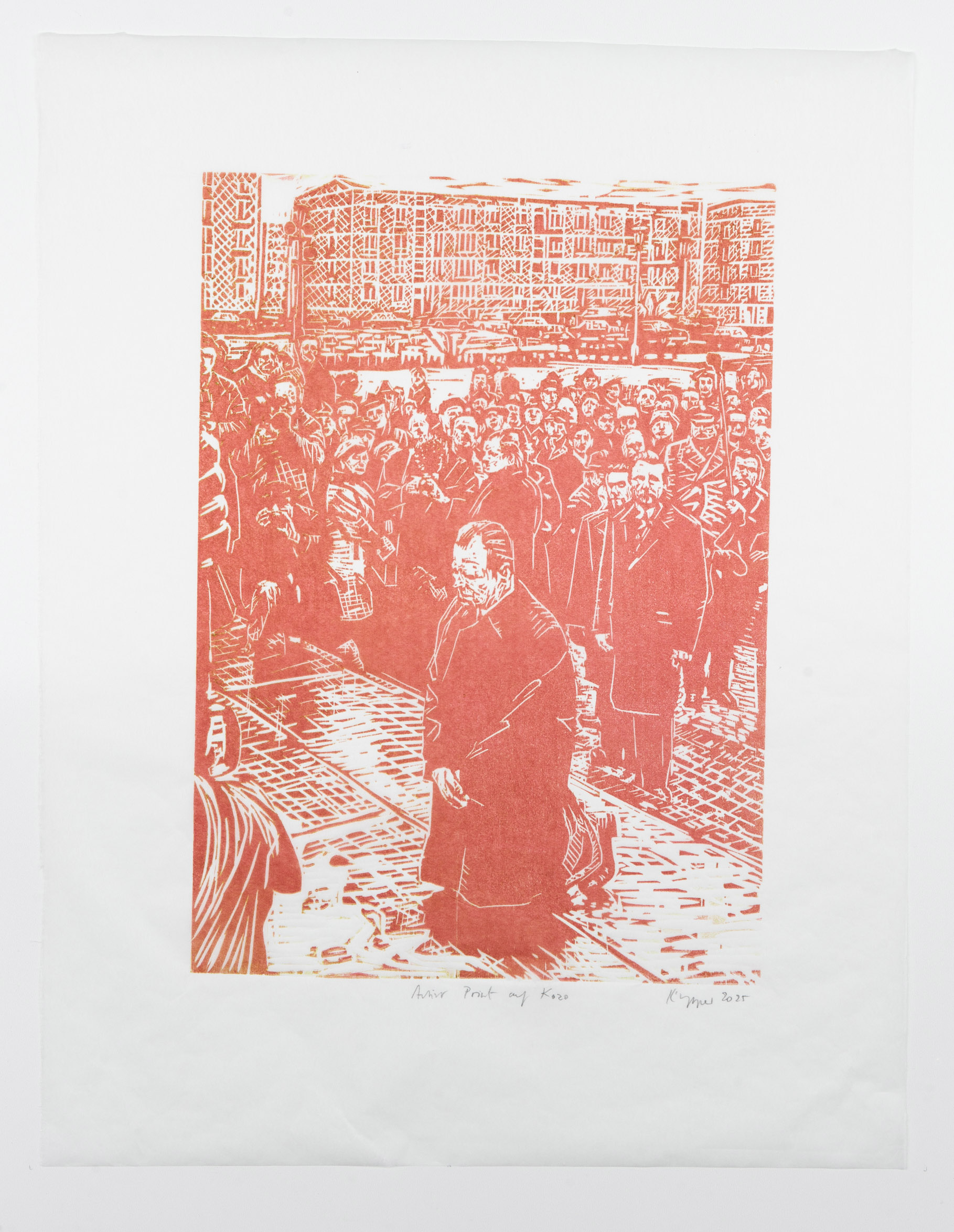
︎︎︎ swipe ︎︎︎
ohne Titel (Willy Brandt in Warschau), 2025
Farbholzschnitt, Auflage: 8 Exemplare auf Manilahanf, Druckmaß ca. 42 x 33 cm
600 €
Gerahmt Holz/Aluminium, Museumsglas zzgl. 190 €
︎ Anfrage / request
versandkostenfrei in Deutschland, EU 30 €
free shipping in Germany, 30 € in EU
Farbholzschnitt, Auflage: 8 Exemplare auf Manilahanf, Druckmaß ca. 42 x 33 cm
600 €
Gerahmt Holz/Aluminium, Museumsglas zzgl. 190 €
︎ Anfrage / request
versandkostenfrei in Deutschland, EU 30 €
free shipping in Germany, 30 € in EU

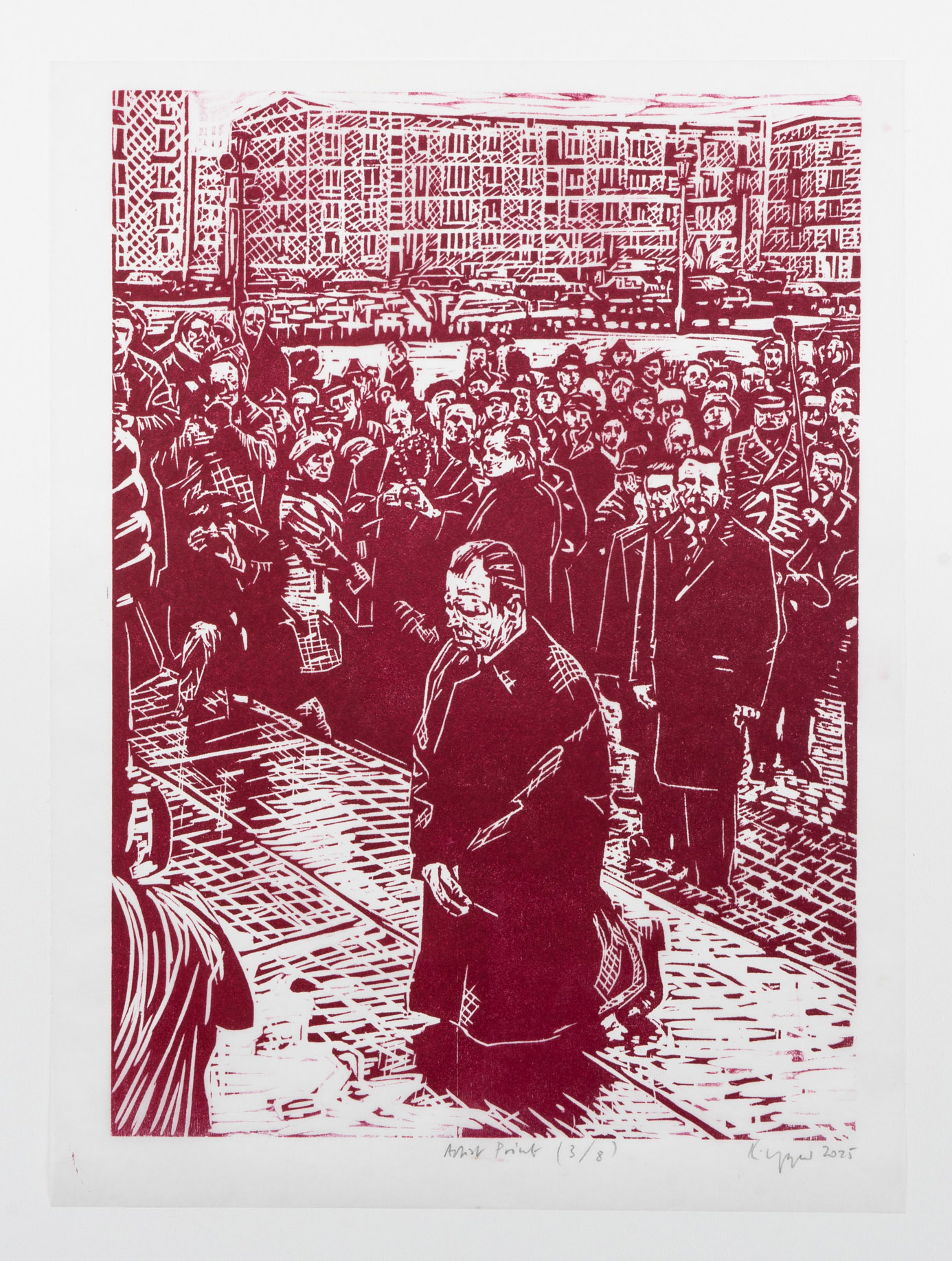


︎︎︎ swipe ︎︎︎
Geist, 2025
Farbholzschnitt, Unikat auf Manilahanf/Kozo
Druckmaß ca. 42 x 33 cm, verschiedene Blattmaße
600 €
Gerahmt Holz/Aluminium, Museumsglas zzgl. 190 €
︎ Anfrage / request
versandkostenfrei in Deutschland, EU 30 €
free shipping in Germany, 30 € in EU





︎︎︎ swipe ︎︎︎
Drug City, 2025
Farbholzschnitt, Unikat auf Manilahanf/Kozo
Druckmaß ca. 50 x 40 cm, verschiedene Blattmaße
600 €
Gerahmt Holz/Aluminium, Museumsglas zzgl. 190 €
︎ Anfrage / request
versandkostenfrei in Deutschland, EU 30 €
free shipping in Germany, 30 € in EU


︎︎︎ swipe ︎︎︎
Blut & Boden Kulturstaatsminister, 2025
Farbholzschnitt, Unikat auf Manilahanf/Kozo
Druckmaß ca. 50 x 40 cm, verschiedene Blattmaße
600 €
Gerahmt Holz/Aluminium, Museumsglas zzgl. 190 €
︎ Anfrage / request
versandkostenfrei in Deutschland, EU 30 €
free shipping in Germany, 30 € in EU
Farbholzschnitt, Unikat auf Manilahanf/Kozo
Druckmaß ca. 50 x 40 cm, verschiedene Blattmaße
600 €
Gerahmt Holz/Aluminium, Museumsglas zzgl. 190 €
︎ Anfrage / request
versandkostenfrei in Deutschland, EU 30 €
free shipping in Germany, 30 € in EU

Sagfjordbotn, 2025
Farbholzschnitt, Unikat auf Manilahanf/Kozo
Druckmaß ca. 50 x 40 cm, verschiedene Blattmaße
600 €
Gerahmt Holz/Aluminium, Museumsglas zzgl. 190 €
︎ Anfrage / request
versandkostenfrei in Deutschland, EU 30 €
free shipping in Germany, 30 € in EU
Farbholzschnitt, Unikat auf Manilahanf/Kozo
Druckmaß ca. 50 x 40 cm, verschiedene Blattmaße
600 €
Gerahmt Holz/Aluminium, Museumsglas zzgl. 190 €
︎ Anfrage / request
versandkostenfrei in Deutschland, EU 30 €
free shipping in Germany, 30 € in EU



︎︎︎ swipe ︎︎︎
Shireen Abu Akleh, Journalist, 2025
Farbholzschnitt, Unikat auf Manilahanf/Kozo
Druckmaß ca. 50 x 40 cm, verschiedene Blattmaße
600 €
Gerahmt Holz/Aluminium, Museumsglas zzgl. 190 €
︎ Anfrage / request
versandkostenfrei in Deutschland, EU 30 €
free shipping in Germany, 30 € in EU
Farbholzschnitt, Unikat auf Manilahanf/Kozo
Druckmaß ca. 50 x 40 cm, verschiedene Blattmaße
600 €
Gerahmt Holz/Aluminium, Museumsglas zzgl. 190 €
︎ Anfrage / request
versandkostenfrei in Deutschland, EU 30 €
free shipping in Germany, 30 € in EU

Planet, 2025
Farbholzschnitt, Unikat auf Manilahanf/Kozo
Druckmaß ca. 50 x 40 cm, verschiedene Blattmaße
600 €
Gerahmt Holz/Aluminium, Museumsglas zzgl. 190 €
︎ Anfrage / request
versandkostenfrei in Deutschland, EU 30 €
free shipping in Germany, 30 € in EU
Farbholzschnitt, Unikat auf Manilahanf/Kozo
Druckmaß ca. 50 x 40 cm, verschiedene Blattmaße
600 €
Gerahmt Holz/Aluminium, Museumsglas zzgl. 190 €
︎ Anfrage / request
versandkostenfrei in Deutschland, EU 30 €
free shipping in Germany, 30 € in EU

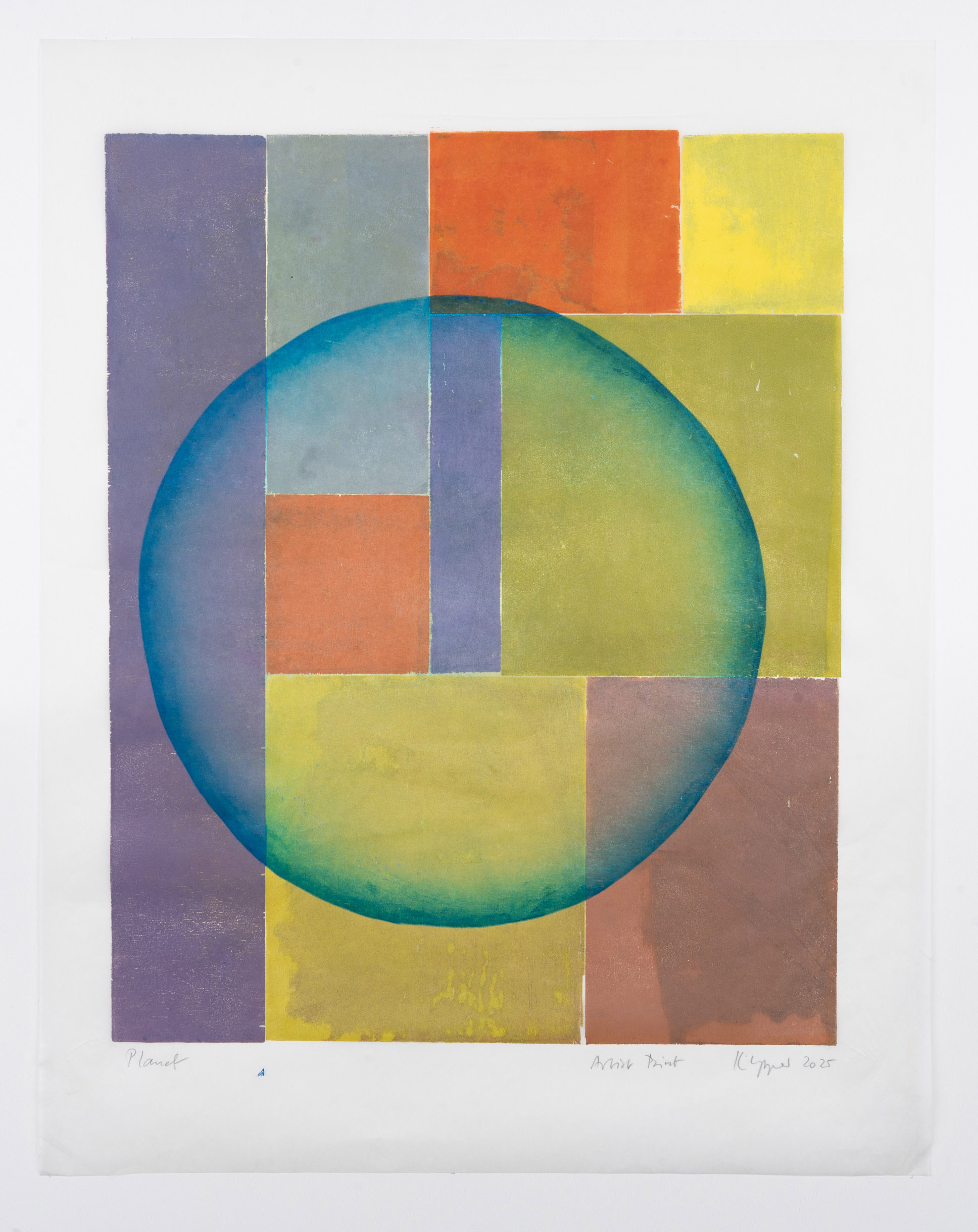

︎︎︎ swipe ︎︎︎
Lukasz Krupski, tesla files, 2025
Farbholzschnitt, Unikat auf Manilahanf/Kozo
Druckmaß ca. 50 x 40 cm, verschiedene Blattmaße
600 €
Gerahmt Holz/Aluminium, Museumsglas zzgl. 190 €
︎ Anfrage / request
versandkostenfrei in Deutschland, EU 30 €
free shipping in Germany, 30 € in EU
Farbholzschnitt, Unikat auf Manilahanf/Kozo
Druckmaß ca. 50 x 40 cm, verschiedene Blattmaße
600 €
Gerahmt Holz/Aluminium, Museumsglas zzgl. 190 €
︎ Anfrage / request
versandkostenfrei in Deutschland, EU 30 €
free shipping in Germany, 30 € in EU

ohne Titel, 2025
Farbholzschnitt, Unikat auf Manilahanf/Kozo
Druckmaß ca. 50 x 40 cm, verschiedene Blattmaße
600 €
Gerahmt Holz/Aluminium, Museumsglas zzgl. 190 €
︎ Anfrage / request
versandkostenfrei in Deutschland, EU 30 €
free shipping in Germany, 30 € in EU
Farbholzschnitt, Unikat auf Manilahanf/Kozo
Druckmaß ca. 50 x 40 cm, verschiedene Blattmaße
600 €
Gerahmt Holz/Aluminium, Museumsglas zzgl. 190 €
︎ Anfrage / request
versandkostenfrei in Deutschland, EU 30 €
free shipping in Germany, 30 € in EU


︎︎︎ swipe ︎︎︎

Großformate:
Unikat Holzdrucke aus dem Projekt Woodcut Maelstrom, 2024, vom Künstler gedruckt (Artist Prints / A.P.) auf Römerturm 100% Manilahanf
hier: Audre Lorde (1934-1992) mit Zitat “Your Silence will not protect you”, ca. 133 x 100 cm
2.800 €
︎ Anfrage / request
versandkostenfrei in Deutschland, EU 30 €
free shipping in Germany, 30 € in EU
Unikat Holzdrucke aus dem Projekt Woodcut Maelstrom, 2024, vom Künstler gedruckt (Artist Prints / A.P.) auf Römerturm 100% Manilahanf
hier: Audre Lorde (1934-1992) mit Zitat “Your Silence will not protect you”, ca. 133 x 100 cm
2.800 €
︎ Anfrage / request
versandkostenfrei in Deutschland, EU 30 €
free shipping in Germany, 30 € in EU
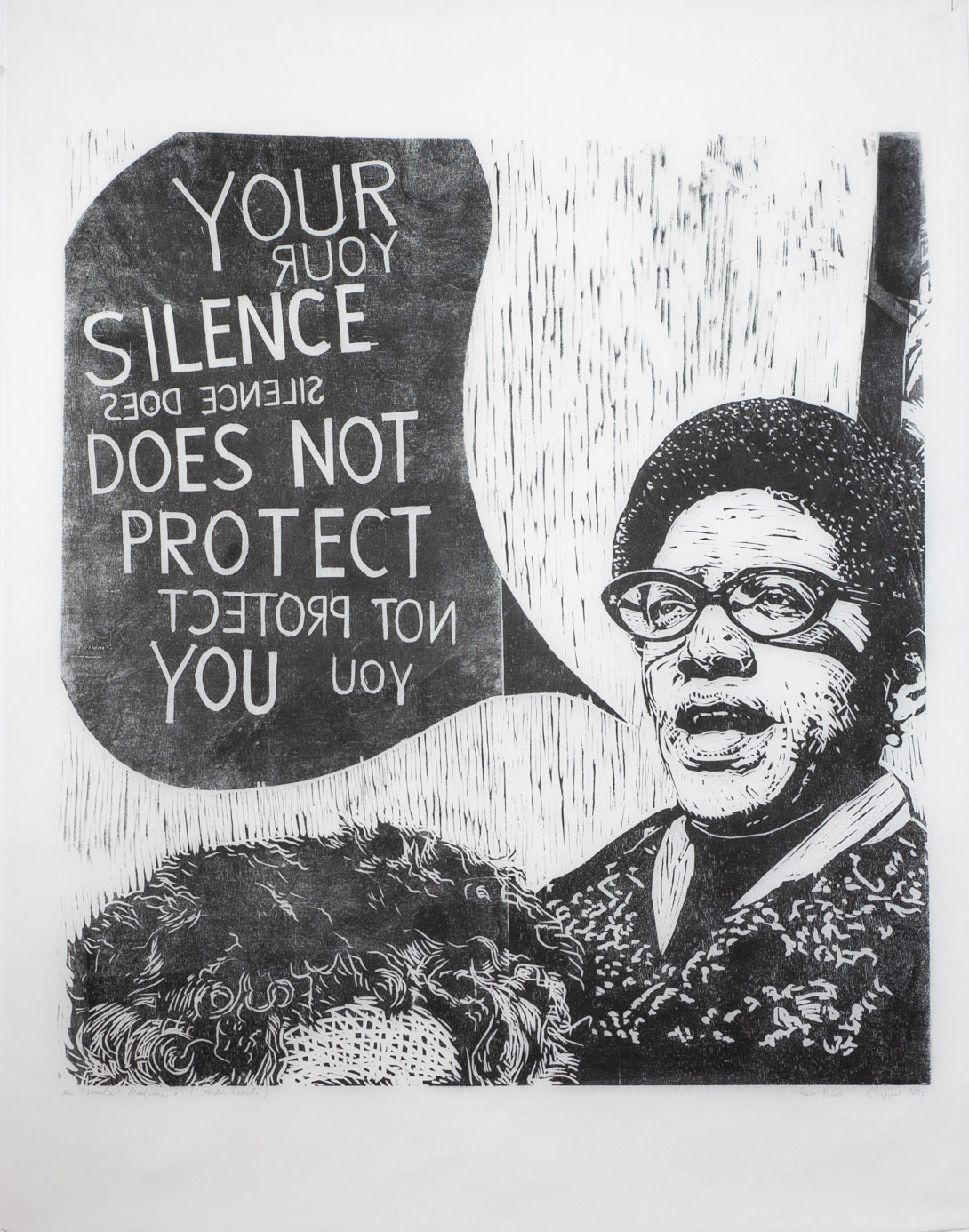
Nzingalisa nach LaToya M. Hobbs zeigt Holzschnitt aus Mein
Stundenbuch nach Frans Masareel, ca. 188 x 100 cm
︎ Anfrage / request
︎ Anfrage / request

Imane Khelif (*1999) präsentiert den Holzschnitt Frau mit Träne nach Nicole Eisenman, ca. 154 x 100 cm
4.500 €
︎ Anfrage / request
versandkostenfrei in Deutschland, EU 30 €
free shipping in Germany, 30 € in EU
4.500 €
︎ Anfrage / request
versandkostenfrei in Deutschland, EU 30 €
free shipping in Germany, 30 € in EU
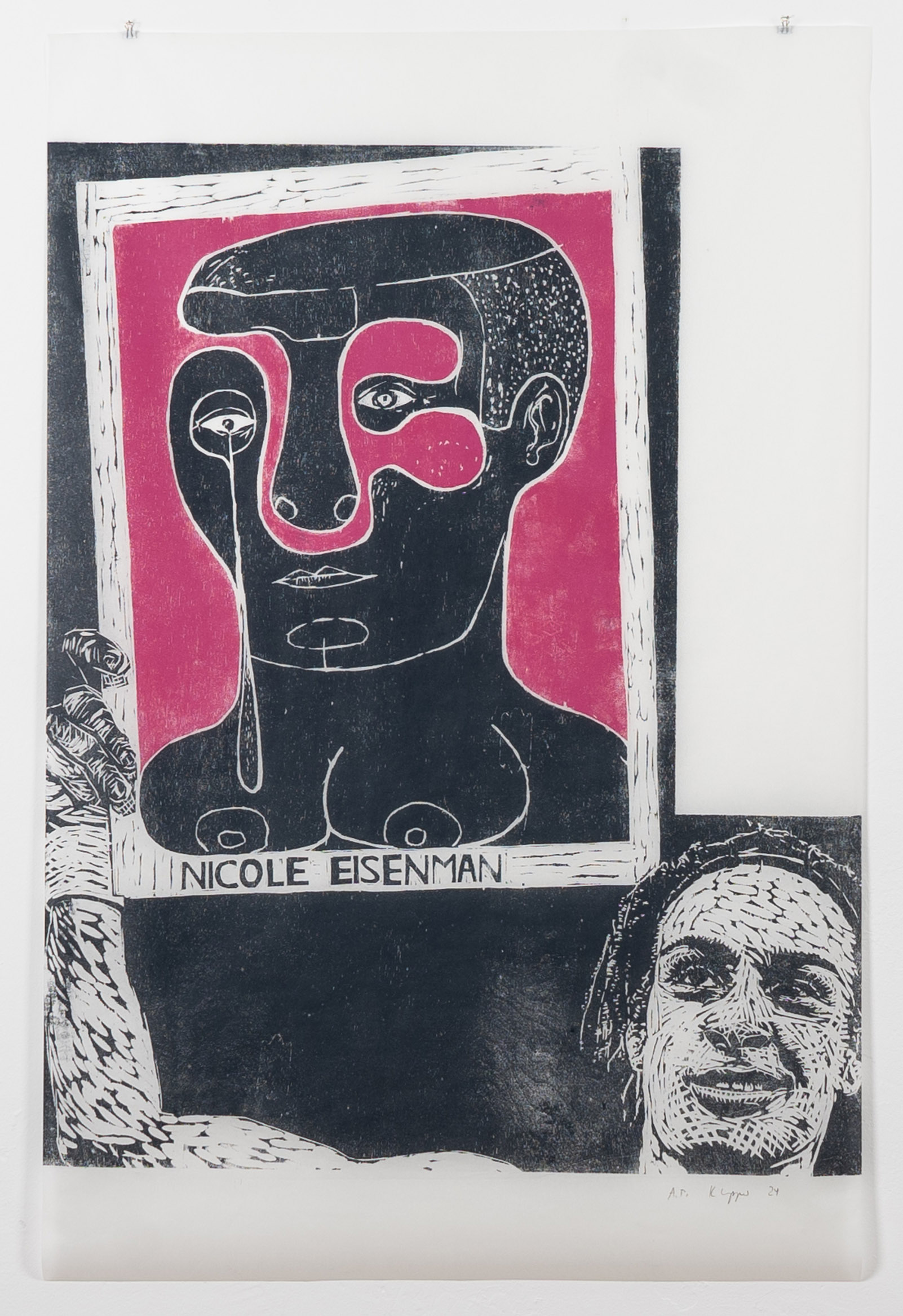
Michael Barenboim (*1985) zeigt den Holzschnitt Fieldwork nach Jak Katarikawe (Uganda, 1938-2018), ca. 181 x 100 cm
4.900 €
︎ Anfrage / request
versandkostenfrei in Deutschland, EU 30 €
free shipping in Germany, 30 € in EU
4.900 €
︎ Anfrage / request
versandkostenfrei in Deutschland, EU 30 €
free shipping in Germany, 30 € in EU
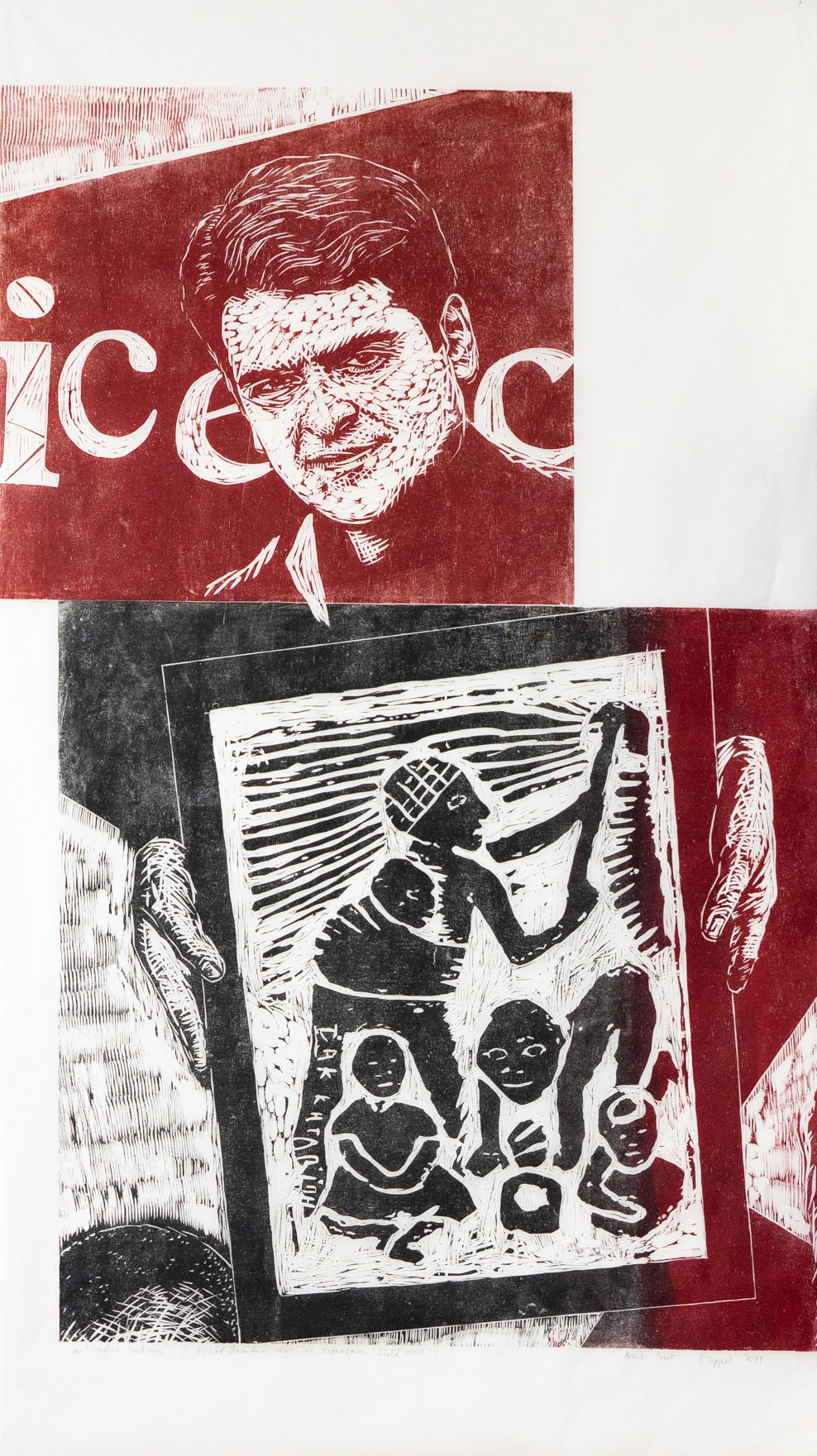

Eyal Weizman (*1970) zeigt Splitting von 1973, ein ‘Holzschnitt’ der besonderen Art: ein komplett geteiltes Holzhaus von Gordon Matta Clark (1943-78), ca. 182 x 100 cm
4.900 €
︎ Anfrage / request
versandkostenfrei in Deutschland, EU 30 €
free shipping in Germany, 30 € in EU
4.900 €
︎ Anfrage / request
versandkostenfrei in Deutschland, EU 30 €
free shipping in Germany, 30 € in EU

Bénédict Savoy (*1972) zeigt den bis heute ältesten bekannten Holzschnitt Diamond Sutra von 868 n.Chr. aus China, ca. 164 x 100 cm
︎ Anfrage / request
︎ Anfrage / request

Susan Neiman (*1955), ca. 84 x 100 cm
1.500 €
︎ Anfrage / request
versandkostenfrei in Deutschland, EU 30 €
free shipping in Germany, 30 € in EU
1.500 €
︎ Anfrage / request
versandkostenfrei in Deutschland, EU 30 €
free shipping in Germany, 30 € in EU

Emilia Roig (*1983) präsentiert den Holzschnitt Dorothea Sternheim von 1916 nach Ernst Ludwig Kirchner, ca. 180 x 100 cm
︎ Anfrage / request
︎ Anfrage / request

Die antifaschistische Widerstandskämpferin Hilde Coppi (1909-1945) zeigt den Holzschnitt Bürgerkrieg von 1928 nach Gerd Arntz (1900-1988), ca. 170 x 100 cm
4.900 €
︎ Anfrage / request
versandkostenfrei in Deutschland, EU 30 €
free shipping in Germany, 30 € in EU
4.900 €
︎ Anfrage / request
versandkostenfrei in Deutschland, EU 30 €
free shipping in Germany, 30 € in EU
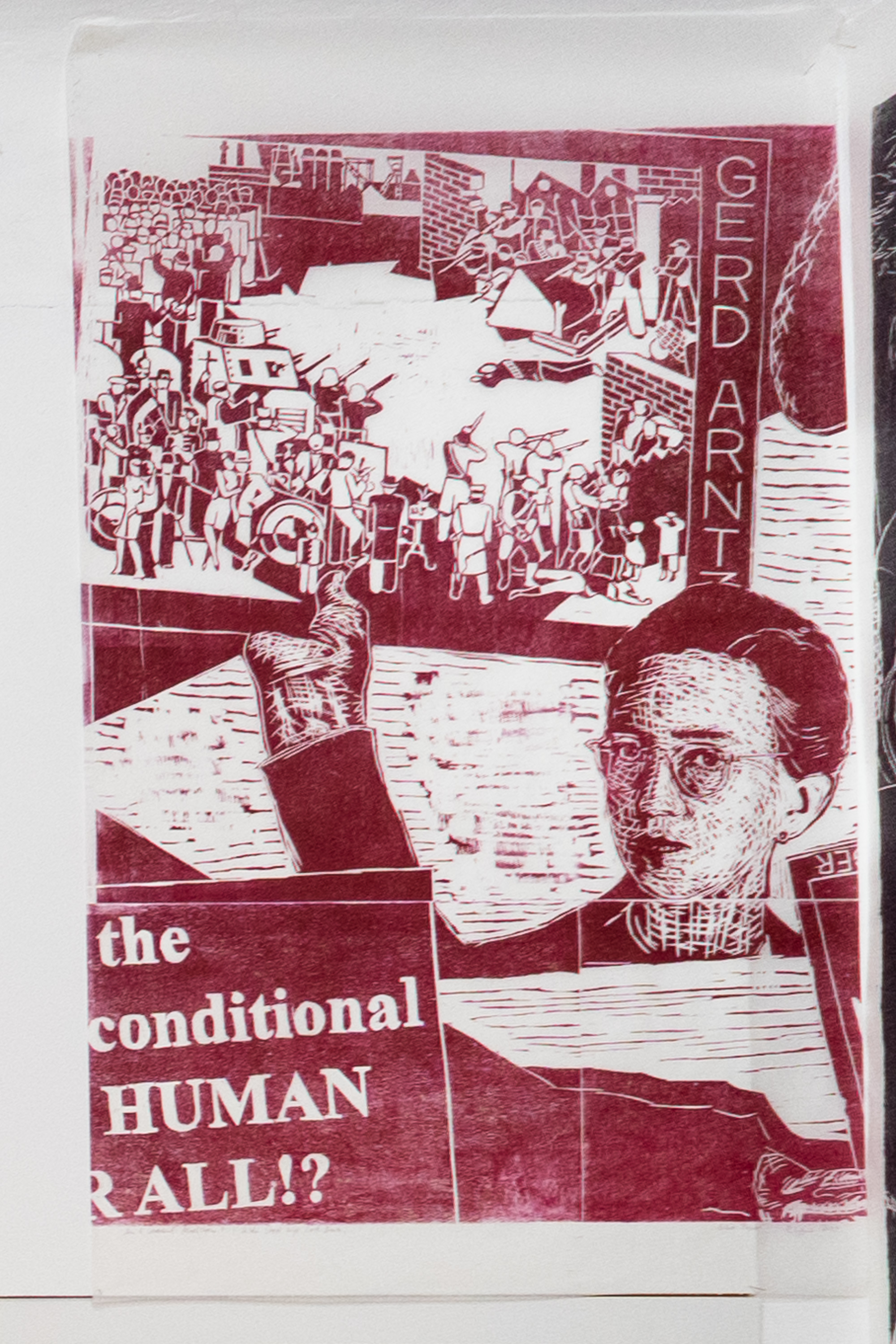

Susan Neiman (*1955) zeigt den Holzschnitt Drei Wege, Stafelalp, von 1916 nach Ernst Ludwig Kirchner, ca. 191 x 100 cm
︎ Anfrage / request
︎ Anfrage / request

Donna Haraway (*1944) zeigt den Holzschnitt Ego Sum Papa von 1499, eine Kritik an Papst Alexander VI. (1431–1503) aus Frankreich, ca 146 x 100 cm
4.500 €
︎ Anfrage / request
versandkostenfrei in Deutschland, EU 30 €
free shipping in Germany, 30 € in EU
4.500 €
︎ Anfrage / request
versandkostenfrei in Deutschland, EU 30 €
free shipping in Germany, 30 € in EU
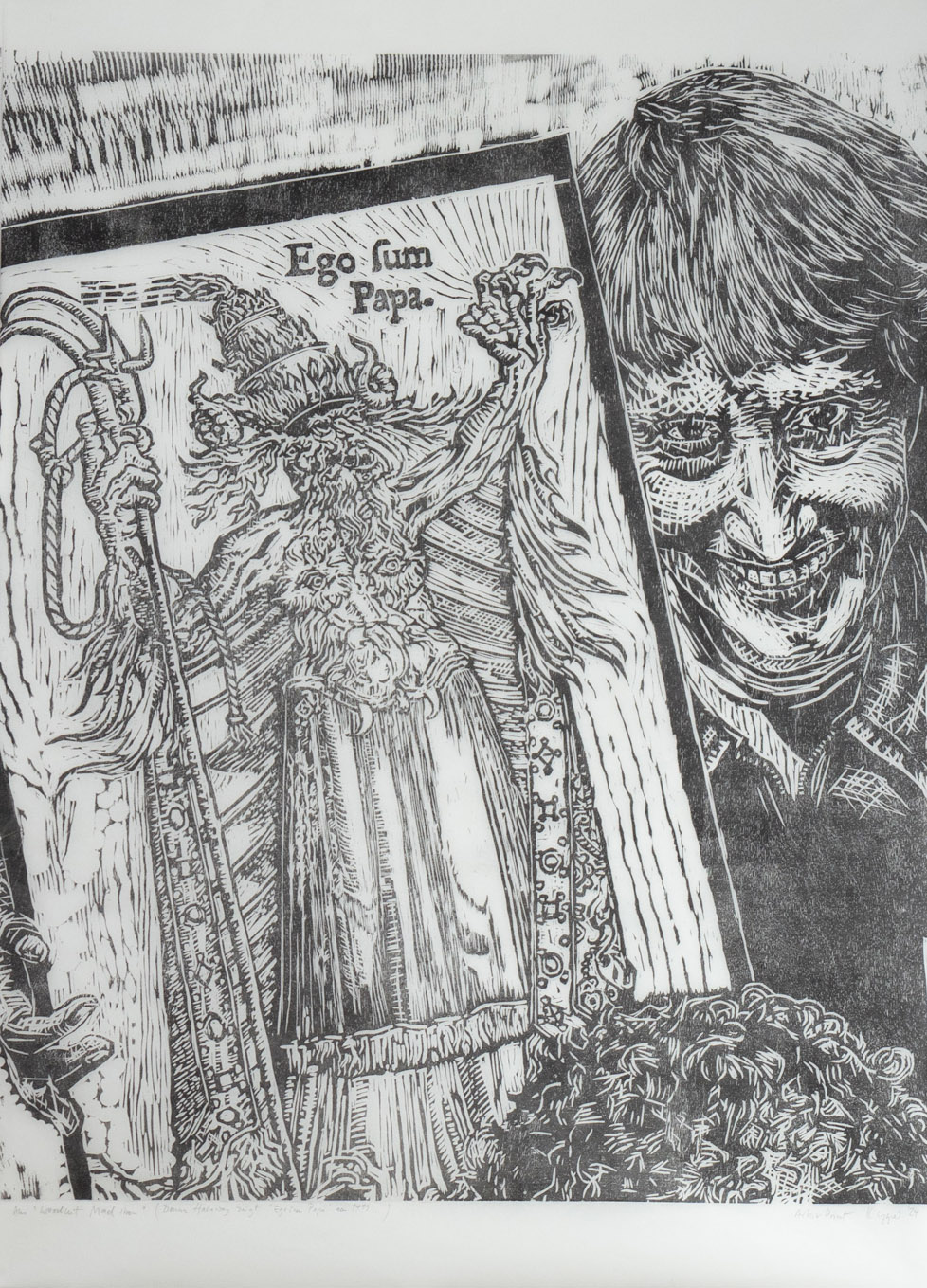
Kasper König (1943-2024) präsentiert einen Holzschnitt aus dem Zyklus Wege der Weltweisheit: Gottfried Keller von 1977 nach Anselm Kiefer (*1945), ca. 183 x 100 cm
︎ Anfrage / request
︎ Anfrage / request
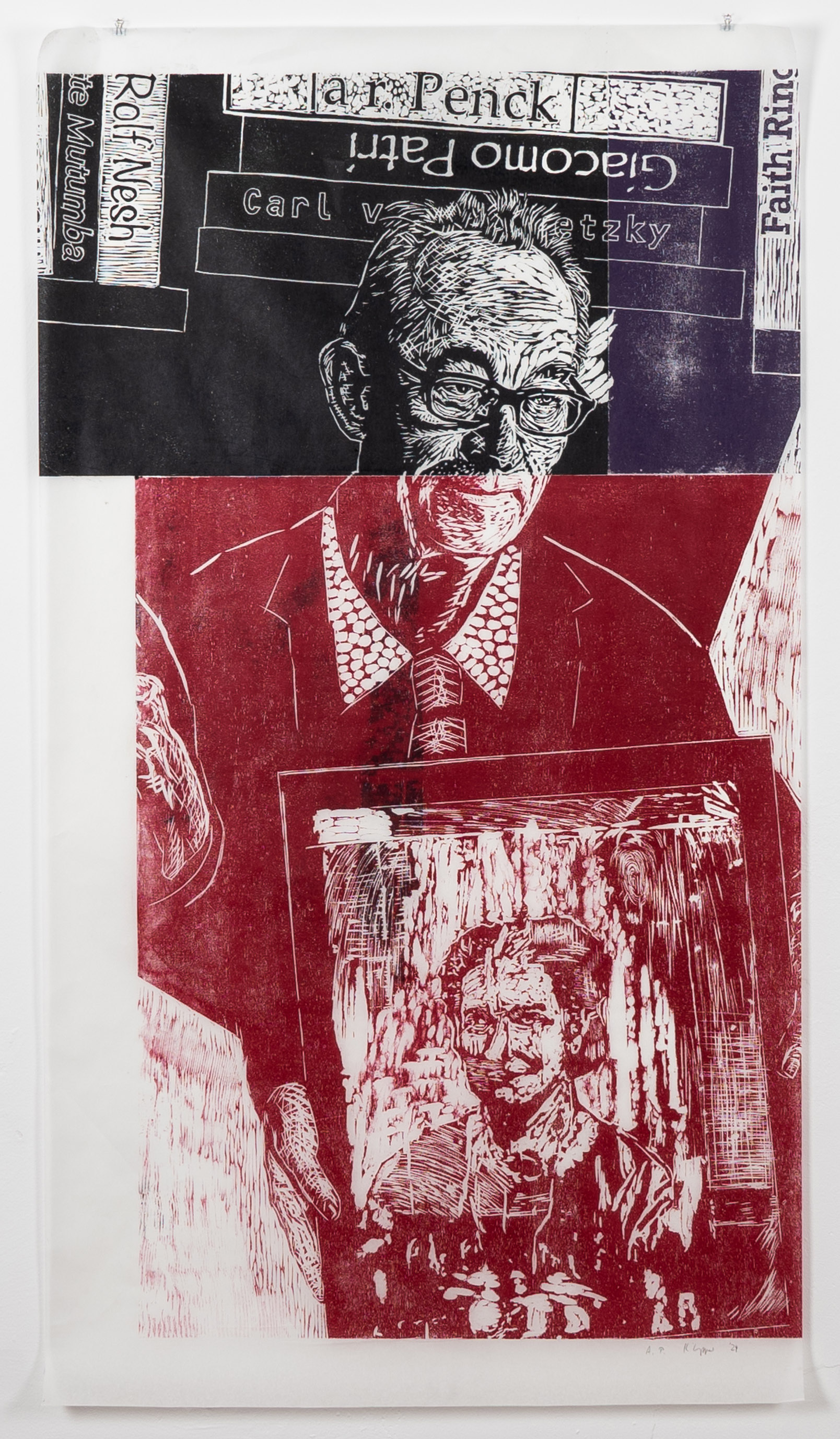
Die Bücher zeigen wichtige Referenzen für Thomas Kilpper und das Holzschnitt Projekt Woodcut Maelstrom. Dazwischen hängt der Holzschnitt "taking the knee (Willy Brandt 1970)" aus dem Jahr 2022, ca. 150 x 100 cm
4.500 €
︎ Anfrage / request
versandkostenfrei in Deutschland, EU 30 €
free shipping in Germany, 30 € in EU
4.500 €
︎ Anfrage / request
versandkostenfrei in Deutschland, EU 30 €
free shipping in Germany, 30 € in EU

Igor Levit (*1987) zeigt den Holzschnitt Komponist Otto Klemperer von 1916 nach Ernst Ludwig Kirchner, ca. 172 x 100 cm
︎ Anfrage / request
︎ Anfrage / request

Thomas Kilpper präsentiert das modifizierte Cover des Magazins Der Spiegel von Oktober 2023 mit dem damaligen Bundeskanzler Olaf Scholz, ca. 178 x 100 cm
4.900 €
︎ Anfrage / request
versandkostenfrei in Deutschland, EU 30 €
free shipping in Germany, 30 € in EU
4.900 €
︎ Anfrage / request
versandkostenfrei in Deutschland, EU 30 €
free shipping in Germany, 30 € in EU


Thomas Kilpper, © Edinburgh Printmakers
more Thomas Kilpper